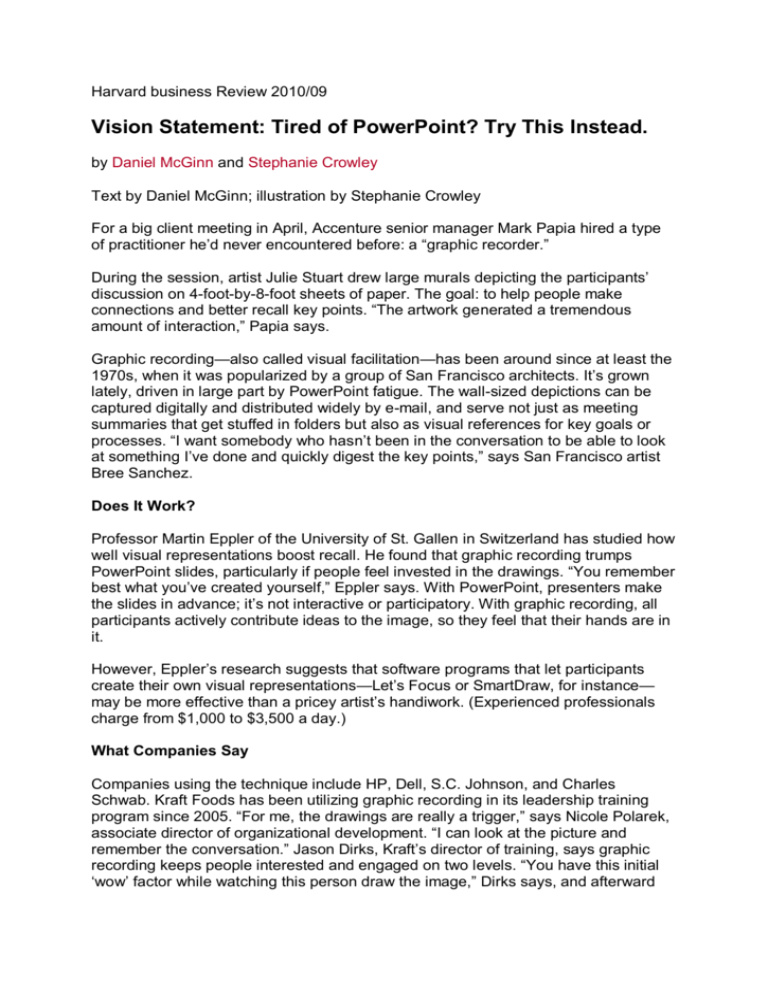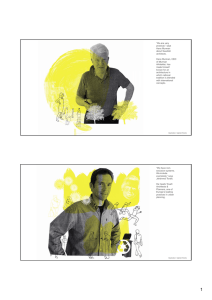Vision Statement: Tired of PowerPoint? Try This Instead.
advertisement

Harvard business Review 2010/09 Vision Statement: Tired of PowerPoint? Try This Instead. by Daniel McGinn and Stephanie Crowley Text by Daniel McGinn; illustration by Stephanie Crowley For a big client meeting in April, Accenture senior manager Mark Papia hired a type of practitioner he’d never encountered before: a “graphic recorder.” During the session, artist Julie Stuart drew large murals depicting the participants’ discussion on 4-foot-by-8-foot sheets of paper. The goal: to help people make connections and better recall key points. “The artwork generated a tremendous amount of interaction,” Papia says. Graphic recording—also called visual facilitation—has been around since at least the 1970s, when it was popularized by a group of San Francisco architects. It’s grown lately, driven in large part by PowerPoint fatigue. The wall-sized depictions can be captured digitally and distributed widely by e-mail, and serve not just as meeting summaries that get stuffed in folders but also as visual references for key goals or processes. “I want somebody who hasn’t been in the conversation to be able to look at something I’ve done and quickly digest the key points,” says San Francisco artist Bree Sanchez. Does It Work? Professor Martin Eppler of the University of St. Gallen in Switzerland has studied how well visual representations boost recall. He found that graphic recording trumps PowerPoint slides, particularly if people feel invested in the drawings. “You remember best what you’ve created yourself,” Eppler says. With PowerPoint, presenters make the slides in advance; it’s not interactive or participatory. With graphic recording, all participants actively contribute ideas to the image, so they feel that their hands are in it. However, Eppler’s research suggests that software programs that let participants create their own visual representations—Let’s Focus or SmartDraw, for instance— may be more effective than a pricey artist’s handiwork. (Experienced professionals charge from $1,000 to $3,500 a day.) What Companies Say Companies using the technique include HP, Dell, S.C. Johnson, and Charles Schwab. Kraft Foods has been utilizing graphic recording in its leadership training program since 2005. “For me, the drawings are really a trigger,” says Nicole Polarek, associate director of organizational development. “I can look at the picture and remember the conversation.” Jason Dirks, Kraft’s director of training, says graphic recording keeps people interested and engaged on two levels. “You have this initial ‘wow’ factor while watching this person draw the image,” Dirks says, and afterward people can study the depiction more closely. “The artists are able to capture a lot of depth.” A Fresh Look at “Marketing Myopia” Graphic recorder Stephanie Crowley depicts the central themes of the classic 1960 HBR article by Ted Levitt. Written By Daniel McGinn is a senior editor at HBR. Stephanie Crowley is the founder of Chrysalis Studios in Los Angeles. juliestuart 2 months ago Hi, I’m the graphic facilitator mentioned in the first paragraph. After reading this article, I felt like the writer got some things right and some things wrong about my work, so I had a few things to say about that on my blog at Making Ideas Visible which has started a lively discussion about: The deep, and difficult to measure, impacts and value of visual facilitation. Bringing the worlds of art and business, left and right brain together to foster innovation, How visuals engage the whole brain thru pattern-making. Why we take issue with our work being called “pricey artist’s handiwork” and why we should actually embrace that characterization. How facilitating businesses to draw their own metaphors is powerful, strategy-driving stuff. Why a drawing software program can’t replace 10,000 hours of mastery a la Gladwell. That talking about, branding and marketing what we do is challenging for many reasons. And a few more interesting thoughts from my colleagues, my clients and many others. Googleöversättning Visionen: Trött på PowerPoint? Prova här istället. av Daniel McGinn och Stephanie Crowley För ett stort kundmöte i april, hyras Accenture senior manager Mark Papia en typ av läkare han aldrig träffat på förut: ". Grafisk Recorder" en Under sessionen, drog konstnären Julie Stuart stora väggmålningar som skildrar deltagarnas diskussion om 1,2 x 2,5 meters pappersark. Målet: att hjälpa människor att knyta kontakter och bättre minns viktiga punkter. "Konstverket genererade en enorm mängd av interaktion," Papia säger. Grafisk inspelning-även kallad visuell underlättande-har funnits sedan åtminstone 1970-talet, när det var populariserades av en grupp San Francisco arkitekter. Det har växt nyligen, till stor del driven av PowerPoint trötthet. Väggen stora skildringar kan fångas digitalt och distribueras i stor utsträckning via epost, och inte bara fungerar som möte sammanfattningar som få fyllda i mappar men även som visuella referenser till viktiga mål eller processer. "Jag vill ha någon som inte har varit i samtalet för att kunna titta på något jag gjort och snabbt smälta de viktigaste punkterna, säger San Francisco konstnär Bree Sanchez. Fungerar det? Professor Martin Eppler vid universitetet i St Gallen i Schweiz har studerat hur väl visuella representationer öka minns. Han fann att grafisk inspelning trumf PowerPoint-bilder, särskilt om människor känner investerat i ritningarna. "Du minns bäst vad du har skapat själv," Eppler säger. Med PowerPoint, presentatörer göra bilderna i förväg, det är inte interaktiv eller deltagande. Med grafisk inspelning, alla deltagare bidrar aktivt idéer till bilden, så de känner att deras händer är i den. Tyder dock Eppler s forskning som program som låter deltagarna skapa sina egna visuella representationer-Let's Focus eller SmartDraw, till exempel-kan vara mer effektivt än en dyr artist skapelse. (Erfarna medarbetare kostnad från $ 1.000 till $ 3.500 om dagen.) Vad företagen säger Företag som använder tekniken inkluderar HP, Dell, SC Johnson och Charles Schwab. Kraft Foods har använt grafisk inspelning i sitt ledarskap utbildningsprogram sedan 2005. "För mig ritningarna är verkligen en utlösande faktor, säger Nicole Polarek, biträdande chef för organisationsutveckling. "Jag kan titta på bilden och kom ihåg samtalet." Jason Dirks, Krafts chef för träning, säger grafisk inspelning håller folk intresserade och engagerade på två nivåer. "Du har denna första" wow "-faktorn när du tittar på den här personen rita bilden," Dirks säger, och efteråt människor kan studera avbildning närmare. "Konstnärerna har möjlighet att fånga en hel del djup." En ny titt på "Marknadsföring Myopi" Grafisk brännaren Stephanie Crowley skildrar centrala teman i det klassiska 1960 HBR-artikel av Ted Levitt.
